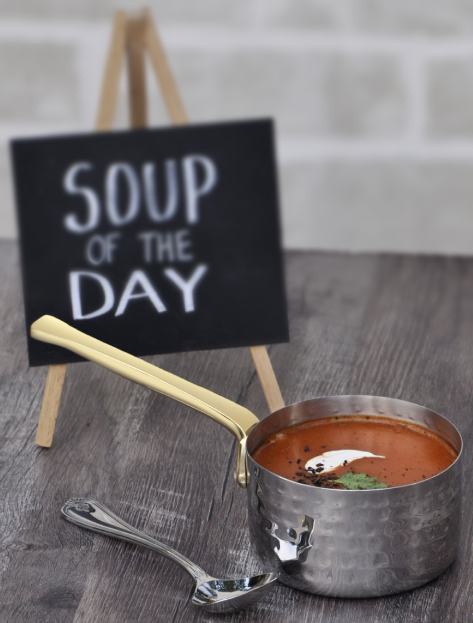Bite-size food presentation in buffets

It has happened in the international culinary mar- kets and now it is happening in India. Picking up cues from the restaurant industry, new-age hotel banquets and outdoor caterers have started creating brilliant food presentations. There are several names for this trending style of display. It is sometimes called amuse-bouche, tapas, single servings, tasting dishes or bite size menus. They all mean the same thing, a series of small vessels, each with bite-sized hors d’oeuvres, laid out in mesmerizing ways on the buffet table. But there is that slight problem of commercializing the exclusive. Sure, the mini bites look great when it is four to eight pieces served on the table in a restaurant. But how do we make it interesting and break the monotony when serving hundreds on a buffet? The answer lies in the recent burst of innovations in buffet servers, risers and elevations.
Guests are tired of seeing large clumps of food displayed and served at even larger buffets. The entire experience is unappetising and a complete failure of our most important sense – sight. Dozens of pieces of disjointed food filled in a large bowl or a gastronorm sized pan, spread out and half eaten mid-way through the event. Chunky dish after dish is lined in a linear fashion that appears like a commercial army of buffet service. It is untidy and unpleasant.
Little servings
In most cases, the experience is unavoidable. As every chef will at some point say ‘chafing dishes are the necessary evil’. Yes, a true fact, but the buffet does not need to completely succumb to it. The buffet needs to work with it, and where possible, get away from it. The best way to compen- sate for those large chunky servings is to mix them up with the new trendy style of servings. These little mini bites, when layered in interesting ways on the buffet, are an absolute feast for the eyes.
The single serving menu style is an art of cuisine in itself. The small bites can be an intensely flavored complex preparation or simple offerings such as pieces of olive or corn. According to Jean-Georges, a popular New York celebrity chef with restaurants around the world, “The amuse-bouche is the best way for a great chef to express his or her big ideas in small bites.” They can be served across cocktails, appetizers, sides for main course and desserts. The flexibility when making mini bites is great. Because of its size, a chef can cook many different recipes and have an impressive menu of amuse-bouche dishes on its own. The buffet will not feel lengthy and tiresome, but instead fresh and innovative. The best part about these little servings is the ability to creatively plate the variety of tapas and display it in innovative ways, creating an entire tasting experience in itself.

The innovations in tasting dishes can be pushed beyond limits and used as a means to showcase the chef’s artistry and showmanship. Using the right vessels, single servings can be served as liquids, semisolids or solids. Possibly the most popular use of bite servings is in appetizers and desserts. Semi – solids such as mini cakes, pies and custards can be created in a myriad of small bowls and dishes. Recent innovations have included serving liquids in test tubes, shot glasses and demitasse cups for cold soups, aperitifs and sauces. Solid foods are possibly the easiest to display in creative ways. Quirky vessels such as soup spoons, mini cones, french fries baskets, ramekins, picks and skewers are extremely popular. And when you want to be incredibly innovative, there is an indian design company which has also released eye-catching mini dishes such as bite-sized handis, tawas, katories, kadhais, ponis and paraats.
Right Presentations
So once the bite-size menu is set and suitable vessels have been acquired for the dishes, it needs to be presented in the right way. So once the bite-size menu is set and suitable vessels have been acquired for the dishes, it needs to be presented in the right way. A flat display on the table is not only boring but can also backfire. The whole idea is not to have a setup that is looking commercial. The layout needs to be creative
and presented in challenging combinations. Risers are available in the market for that purpose. With the help of suitable levels and elevations, the items can be presented in an exciting tiered manner.

When dealing with risers, the chef needs to be careful with the items being used. There are several instances where home-made elevations are created using inverted bowls or pots, steel tubes or wooden boxes. The overall effect should be professional.Laser-cut and fabricated pillars are available in several finishes which can not only break the monotony but can also become the highlight of the presentation. They enhance the decor and add to the event. From a distance, guests are drawn to the layout. As he or she steps closer, the sight moves from the entire layout, to the elevations and finally to the plated food in quirky bite-sized vessels. He/she picks up the vessel out of curiosity and admires the charm of the entire experience.
If a chef wants to maximize culinary innovation in buffets, then he or she needs to think of not only laying the bite-sized vessels on a tabletop surface but suspending them in mid-air. Imagine a layout – the mini dishes are all around you, some on the surface, some elevated to a height and others hanging off holders in the air. The buffet experience is glorified to another level. Unique bites of food in various combinations of taste, plated in beautiful colors and textures, served in little dishes and presented in a four dimensional space. This is the next phase of buffet innovations. It is a trend that is on its way and Indian professional tableware companies have created the right kind of products to be used as tools.



